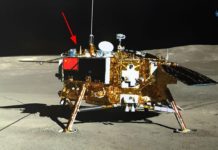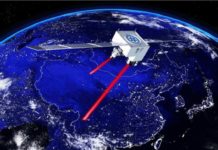Earlier this year, Chinese media outlets announced that researchers from the National Space Science Center in Beijing had come up with a plan to capture an asteroid and steer it back to the Earth’s surface.
The plan was submitted as part of a contest designed to promote interest in the space sciences and engineering, and was entered into the finals with another 59 entrants.
The mission, if realised, aims to identify a resource-rich asteroid, capture it in a giant bag, and then tow it onto an Earth-bound trajectory, where it will deploy a heat shield to stop the asteroid burning up as it re-enters the Earth’s atmosphere. The researchers say that they want the asteroid to “land” in a unpopulated area- presumably somewhere in China.
Do take a moment to subscribe to our email newsletter here. We will not sell your email address to a third party, and you can unsubscribe anytime.
We have heard a lot about asteroid resource harvesting over the last decade, with numerous companies all vying for a piece of that precious space booty. Many of these companies are focusing on mining the materials in situ, and either sending them back to Earth in smaller chunks or else utilizing the resources in space, and constructing space-based silos for future space-infrastructure development. Very few are brave enough to suggest guiding it back to the Earth’s surface.
So, is the China plan realistic? Or is it a horrific catastrophe waiting to happen?
As far as we know, the project will be split into several phases.
Locate Asteroid
This part is harder than it sounds. Smaller asteroids are notoriously difficult to spot (until it’s too late), especially if they are coming from the direction of the Sun. Our host star wreaks havoc on telescopes, making spotting them very difficult.
To counter this, the team have been working with the China Aerospace Science and Technology Corporation, to draw up a plan for a satellite constellation on a heliocentric Venus-like orbit. The constellation will be used to seek out and analyse asteroids of about 10 metres in diameter.
The team have been testing the theory behind this by looking at a previously discovered asteroid, 100 million kilometres away with a diameter of 6.4 metres with a mass of about “several hundred tonnes”.
Rendezvous and Capture
The next step is to design a spacecraft that is capable of intercepting the asteroid, and capturing it in a huge bag. If my knowledge of Kerbal’s Space Program has taught me anything, they will need to apply a pro-grade burn to widen the orbit so that it matches that of Earth.
The details on this part of the operation are worryingly vague. Will they use gravitational assists to slow the asteroid and spacecraft before putting it into Earth orbit, or will they aim it straight at Earth? Both plans have their downsides. A direct Earth-shot will mean that the asteroid comes in very fast, and they need to make sure their aim is perfect.
Do take a moment to subscribe to our email newsletter here. We will not sell your email address to a third party, and you can unsubscribe anytime.
Putting the asteroid into Earth orbit after a series of gravitational assists seems to be the safer option…although satellite operators may take issue with this plan. It all depends on what kind of orbit they wish to park it in really. LEO is getting pretty busy, and GEO is prime real estate.
Maybe putting it into lunar orbit would be the safer option?
Landing It
According to Chinese media agency Xinhua, team researcher Li Mengtao says that the hardest challenge might be the control of the asteroid after it enters the Earth’s atmosphere.
For this phase, the team proposes the design of a heat shield, which will (somehow) reduce the speed of the asteroid from 12.5 km per second to about 140 meters per second before it touches down at a (hopefully) designated area.
How this heat shield will slow the asteroid in question is not specified. However, we can guess that the heatshield will help maintain the integrity of the asteroid, allowing it to keep a large drag coefficient, and therefore assist with aerobraking manoeuvres once it hits the atmosphere. When asteroids normally hit the Earth, they are slowed down significantly by the thick soup of our atmosphere…but at the same time, they lose mass as they break up due to thermal stress.
They may even design the heatshield in a manner that encourages the loss of velocity due to drag. But that solution has its own problem…the asteroid isn’t losing mass!! When asteroids normally hit the Earth’s surface, they generally tend to be reduced in size by the time they hit the Earth (if they don’t airburst)…they tend to fall at a slowed pace due to drag and the kinetic energy of the impact is reduced thanks to loss of mass and velocity. These guys only want to reduce the velocity. Tricky.
Kinetic Energy
Right, so they want to maintain the mass of the asteroid, but they want it to land gently on the Earth’s surface. They not only want to have their cake, but they want to eat it too.
Let’s have a look at the numbers that were quoted.
They plan to reduce the velocity of a “several hundred” tonne asteroid (let’s say 200 tonnes, to be conservative) from 12.5 km per second down to a leisurely 140 metres per second, or 504 kilometres per hour.
By reducing the velocity of the space rock down to 140 metres per second they will lower the kinetic energy of the impact to 1.96 gigajoules.
And if the braking manoeuvres don’t work? A 200 tonne meteorite hitting the Earth’s surface will impact with the force of 15.625 terajoules, which is roughly equivalent to a 3.7 kiloton detonation.
We hope they’re adding some redundancy to that heatshield/brake system. And we hope their aim is true!







